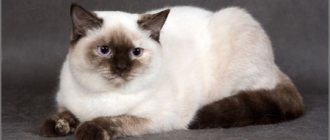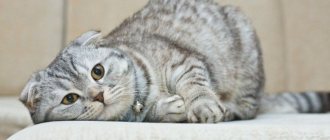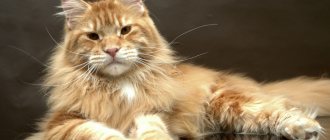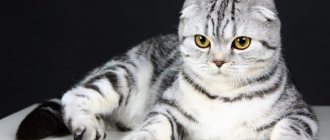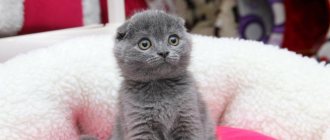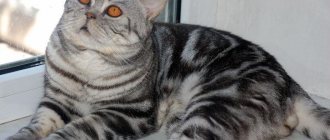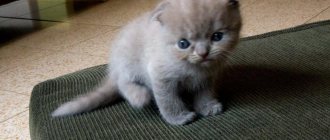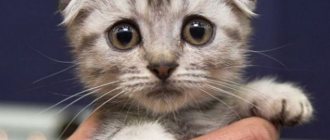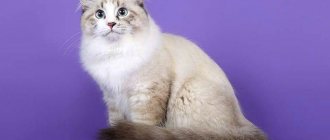The Scottish Fold cat is one of the most popular in the world. She won millions of hearts with her resemblance to a plush toy. The highlight of this breed is the special shape of the ears, which are slightly tilted forward and curved down. Behind the pretty appearance lies a noble and vulnerable character. Before you decide to get a Scottish Fold, you should get to know her better and study the recommendations for keeping, feeding and breeding a cat.
History of the breed
Before we talk about Scottish Folds, it’s worth talking about where they came from. From the name it is obvious: from Scotland. In fact, the breed appeared completely by accident: from a mixture of a British cat and a mongrel.
The ears are curved due to a gene mutation, which, by the way, occurs when mating with ordinary straight-eared cats. If you breed two Scots, the kitten may have serious ear problems.
© shutterstock
In the second half of the twentieth century, in 1963, geneticists began to breed offspring of this breed, which they called Scottishfold, and babies whose ears never curled were called Scottish straight.
Breeding Features
Sexual maturity in Scottish Folds occurs at 7–8 months. However, it is too early to give a cat for breeding at this age. You need to miss at least 3 heats. This time is necessary for the expectant mother’s body to become stronger and for her to be able to bear healthy offspring.
Breeding cats of this breed has some peculiarities. Crossing of lop-eared individuals was prohibited in order to prevent genetic mutations. The mating of two folds usually results in kittens with abnormal bone and joint development. You can only cross Scottish Folds with Scottish Straights, straight-eared cats. In rare cases, representatives of the British breed are chosen as a mating partner in order to update the set of genes.
Pregnancy lasts approximately 65–68 days. A Scottish Fold cat has a litter of 2 to 5 kittens. Half of the cubs inherit the gene for lop ears, the rest have straight ears. You can determine which of them is fold and which is straight once they reach three weeks of age.
Appearance
The Scottish Fold cat breed stands out among others, of course, thanks to the unusual shape of its ears - small, moving forward and down, rounded at the tips. By the way, a kitten’s ears drop when they are 3-4 months old , and those whose ears remain straight are called Scottish Straight. But this is far from their only distinguishing feature.
In addition, these animals have a round muzzle and clearly defined whisker pads (this feature, by the way, is passed down from the British). Not only the head is quite rounded, but also, in principle, the entire body, which gives it not an angular, but a smoother shape. In addition, the body and legs are muscular. The eyes are pronounced, like two saucers - large and widely set, usually yellow or green in color.
By the way, white cats often have heterochromia - their eyes are different colors. Short but fairly wide nose.
British colors
There is a common misconception that the color of British cats must be blue (gray). However, it is not. A specific color does not distinguish a breed from others. Representatives of this breed have quite a lot of color types, and each of them has its own characteristics.
Chocolate
This type of color is considered the rarest. It can be easily distinguished by its uniform coat, which has a rich brown color.
Blue wool color
This shade is the most common among kittens of this breed. Its difference is pure blue, without gray and silver tints as standard. This is also a popular color for the Scots, which is why the question arises of how to distinguish a British cat from a Scottish one. In this case, everyone should remember that the difference between one breed and another is not the color of the coat.
Tortoiseshell
This coloring is also typical for both the British and the Scots. The differences between a British and a Scottish cat of this color are in the depth of color. Among the Scots it is somewhat darker and deeper.
But this color will help to distinguish between the British Shorthair and Scottish Shorthair cats, because it is found only among the British. The Scottish breed also has a similar color, but it is distinguished by greater precision of lines and depth of the gray part of the color.
Black
Black color is very rare, and therefore its owners are highly valued by cat lovers
It is important that the color is clean, without white hairs and spots - these are considered defective. Both males and females can be black
White
Very beautiful and also quite rare - white color. These pets look very aristocratic. Moreover, they are somewhat different even from their own relatives. They are more flexible and their status is thinner and more graceful. They are the only ones characterized by light yellow, light green and green eyes - this is the main difference in color.
Differences
Dense short hair is the standard of the Scottish Fold, but the offspring may also produce a long-haired kitten. The colors of the Scottish Fold are very diverse: from solid to spotted, brindle and even Siamese. The gray fold-eared cat looks interesting, its eyes are copper, orange or green.
So, you can easily recognize a Scot by:
- rounded, downturned ears;
- powerful muscular body and paws;
- round head and body shape;
- huge wide-set saucer eyes.
You can see this from the Scottishfold photo.
© shutterstock
Scots character
Scottish Fold cats are incredibly affectionate and kind. This is the option when a sweet appearance and a gentle character are organically combined. Representatives of the breed easily adapt to a new, hitherto unfamiliar environment (thanks to this, they can often be seen at various exhibitions, because the Scotsman is not a timid cat). By the way, this same character trait makes it possible to take representatives of the Scottish breed with you on trips, as they are easy to transport. Perseverance, calmness and attentiveness also contribute to a cat’s hunting skills.
In addition, they quickly find a common language with other animals and new people. They get along with children absolutely easily and are ready to tolerate some pranks (although the child should still be explained and told how to behave with cats: do not pull the tail and, especially, do not pull the unusual and interesting ears).
This is a cat that likes to live indoors, so it will get along even in a small apartment without any problems, although sometimes it is worth taking it outside.
Content
- History of the origin of the breed
- Description of the breed Colors
- Interaction with children
- Bathing
Attachment
Although the Scotsman is somewhat lazy and a couch potato, he becomes attached to his owner and will be loyal and loving. Therefore, do not be surprised if your pet follows you around the house with its tail - this is how he shows his love, although he never imposes himself, but rather behaves like a friend.
© shutterstock
Their voice is quiet. Both kittens and adults serve it extremely rarely - usually if they ask for food or need help. The Scotsman will not attract the attention of the owner by screaming and meowing, will not destroy the house and create chaos around him.
The Scottish Fold cat breed is quite easy to train, because it is clean in itself - it will not do dirty tricks and walk past the litter box.
We can talk for a long time about the character of the Scottish Fold cat, but to understand it, just watch a video on the Internet.
British
This aristocratic cat breed is one of the most ancient. The breeding of purebred Britons began in the 19th century, and the history of the breed began in antiquity, in the Ancient Roman era.
These cats were actively domesticated by local residents, and together with Roman legionnaires, representatives of the species that was the ancestor of the British were brought to the British Isles.
These animals were very hardy and quickly transitioned from the hot climate of the Mediterranean to the cool weather of England.
Officially, G. Weier is considered the creator of the breed, who selected similar-looking gray, muscular cats for mating. He was also the first organizer of the exhibition of these animals in 1861.
Nuances
Representatives of the Scottish breed like to sleep in a position unusual for other cats - on their backs. You can also often see a fluffy one standing on its hind legs and carefully examining something. This causes affection not only in children, but also in adults.
There are very few disadvantages in the behavior of a Scot:
- sometimes, due to some selfishness and laziness, it is difficult to accustom a cat to something new, but it is quite possible to fight this;
- It is extremely rare, but it happens that a Scotsman does not get along with a dog . But in case of conflict, the cat will simply go to another place;
- gluttony is a minus of the breed, but you should not feed them - follow the recommendations regarding feeding, about which a little later.
Training and education
Scottish Straight
Intelligent by nature, Scottish Straight cats are easy to educate and very difficult to fully train. Teaching a Straight to use a litter box and a scratching post is not at all difficult, provided that this process was started in time, before your pet matures. By the way, young Scottish cats are active and sometimes uncontrollable, so in the first months of the baby’s life you will have to put up with the inevitable destruction in the house.
Even if the fame of Yuri Kuklachev haunts you, it’s better not to get carried away with the serious drill of straights. Whatever the experts say, unquestioning obedience to commands is not the strong point of Scottish straight-eared cats. Instill in your pet the basics of etiquette and teach him to respect subordination - this will be quite enough. As for a full-fledged training program, save it for show-class individuals, who will later have to demonstrate their talents at exhibitions.
- If the animal allows itself too much, try to stop it with the command “No!”, which is given in a stern and loud voice.
- If the kitten does not respond to a stern tone, grab it by the scruff of the neck and imitate a cat hissing. The baby will understand this language faster.
- Do not try to poke the kitten's muzzle into the puddle it has made or try to hammer the basics of cleanliness into it with a slipper. After suffering stress, the cat will definitely play a mischief in another place, but this time it will be reliably hidden from you.
- Have you noticed that your plush beast is sitting in an unambiguous position on the carpet or trying to steal food from the table? Scare him with a loud whistle or clap of your hands. Make no mistake, fear is a very powerful educational tool.
- Never scold or praise a Scottish Straight cat after the fact. Despite a fairly high level of intelligence, the animal is not able to connect together yesterday's exemplary behavior and today's reward.
Purchasing a purebred animal
To be sure of the origin of your pet, you should buy it from a trusted breeder or nursery. If you want to be sure of the purebred nature of your furry, you should pay special attention to the purchase.
Like any purebred animal, a Scot must have special documents:
- birth certificate (this is something like a birth certificate for people);
- a pedigree with a serial number and stamps, which indicates the ancestors on both sides in three generations, taking into account nicknames, colors, and so on;
- veterinary passport;
- purchase and sale agreement.
The most important one here is the first document: the metric indicates all the important data, on the basis of which you can subsequently create all other documents yourself.
© shutterstock
All these papers are needed so that your pet can take part in exhibitions and also mate with other cats. In addition, thanks to a good pedigree, the owner can also earn money . A passport is necessary in order to be able to travel (for trips abroad, accordingly, you need an international passport).
Acquisition
The cost of a tailed one with a pedigree and other documents is certainly higher. In addition, long-haired ones are cheaper.
The approximate price of such animals is from 70 US dollars for a baby without documents, to 170-700 US dollars for a purebred four-legged animal with a pedigree and an interesting rare color.
It is worth noting that it is better not to think about how, in order to save money, buy cheaper and do the documents yourself - this can cost a lot of time and effort, and besides, the baby may not be the same mating as the seller said. If you want to buy a show pet that is suitable for breeding, do not skimp.
Nutrition
As mentioned above, Scottish Folds love to eat, but this does not mean that they need to be fed three portions of food. It is better to feed your pet in smaller portions, but more often .
A kitten aged 1 month can already begin to eat ground chicken or beef, as well as fermented milk products. The further you go, the more variety you can add to your diet: cereal, milk, meat, and so on. It is important not to feed your baby the same food, but to alternate.
From 4 months of age, you can try introducing food to the kitten - first wet, and then dry. But do not forget that dry food is not very beneficial for the body, so always try to please your pet with other food.
A small kitten needs to be fed more often (but not more!) than an adult cat.
Health
Scottish Straights have good good health. To maintain it, do not neglect regular visits to the veterinarian. Before the age of one year, you should follow the vaccination schedule and do not forget about this even when the kitten has grown up. The closer you get to old age, the more often you should visit a doctor. It is recommended to visit the veterinarian 2 times a year when the pet has crossed the 10 year mark.
Regardless of age, a cat should be treated for parasites. By the way, straight-eared Scots are less susceptible to genetic mutations and hereditary diseases, therefore they have enviable health and immunity.
Sometimes Scottish Straights suffer from problems with the stomach and genitourinary system, but this is due to improper maintenance, and not to the health characteristics of purebred cats. Therefore, by taking care of the quality of food and water, the cleanliness of bowls and the freshness of food, you make a huge contribution to the future of your pet.
Scottish cat care
Any animal requires supervision and attention. Caring for a Scottish Fold is not difficult: short-haired ones need to be combed once a week, long-haired ones - two or three times. By the way, this is perhaps the only representative of the cat family that really likes to comb itself against the grain - please your pet.
© shutterstock
You don't need to bathe them often. But the notorious ears require attention and special care. You need to regularly inspect them and clean the sulfur that accumulates there, then your cat will not only be happy, but also healthy.
Diseases
In principle, these are long-lived animals, because their life expectancy is up to 15 years. And even an adult will be just as affectionate, sweet and with a naive look. In order for your pet to live with you as long as possible, you should take care of its health.
Above, in the description of the Scottish Fold cat, it was already said that this breed appeared as a result of a gene mutation of a British man with a mongrel cat.
This is worth paying attention to, because a gene mutation can sometimes play a cruel joke on the health of a representative of the Scottish breed. It is important to know that mating with representatives of your own breed is prohibited - this can lead to serious problems with the ears of the offspring.
In addition, the same gene is responsible for abnormalities in the functioning of the musculoskeletal system of Scots. An overly thick tail and short legs may indicate health problems. Of course, such fluffies look even more cute, but they can suffer serious diseases of the musculoskeletal system in adulthood. Because of this, it can be difficult and painful for the animal to move.
© shutterstock
What are the norms for weight gain for kittens?
The first six months of a kitten's life are the most active in terms of growth. Accordingly, if the baby is healthy and develops normally, he will regularly gain weight:
Before the baby turns 1 month old, he rapidly gains weight - about 15 g per day. At the same time, by the end of the 1st week, the kitten should double its birth weight. Weigh him daily during this period. From 1 to 2 months, weight gain occurs systematically, on average 100–150 g per week. Weigh the baby once every 3 days. After 2 months, weight gain varies from person to person. It depends on the breed and nutrition of the animal. He is weighed weekly for up to 6 months, then once a month for up to a year.
It is important that there is weight gain. If it is absent, you should contact your veterinarian to find out the reasons.
Since there are no exact indicators of body weight gain (much depends on the individual characteristics of the animal, its living conditions and diet), the owner should focus on the average weight standards for kittens.
Table: average body weight of kittens in the first 6 months of life
| Age | Weight |
| 1–6 days | 70–130 g |
| 7 days | 85–200 g |
| 7–14 days | 225–400 g |
| 14–21 days | 285–500 g |
| 1 month | 500–750 g |
| 2 months | 1000–1500 g |
| 3 months | 1700–2300 g |
| 4 months | 2500–3600 g |
| 5 months | 3100–4200 g |
| 6 months | 3500–4800 g |
Short-term stabilization of weight in a kitten
The phenomenon of short-term weight stabilization often occurs. There is no need to panic if the kitten’s weight gain “frozen” for several days, and then continues in the same progression.
Such an anomaly can manifest itself at any time stage of the baby’s life. It often occurs when there is a transition from breastfeeding to regular food (dry food or natural food). This is due to the fact that the baby’s body goes through a period of adaptation to receiving new nutrients.
However, you should worry if there are no changes for more than a few days (for example, a week). This may mean that the kitten is malnourished or sick or infected with parasites. You should visit a veterinarian as soon as possible if, after weight stagnation, body weight begins to decrease rather than increase.
Table: kitten weights by month (values for popular breeds)
| Kitten age | Maine Coon cat weight (g) | Catamein Coon weight (g) | British cat weight (g) | British cat weight (g) | Scottish cat weight (g) | Scottish cat weight (g) |
| Newborn kitten | 120–140 | 120–160 | 60–140 | 70–140 | 60–140 | 70–140 |
| 1 Week | 180–230 | 200–260 | 110–250 | 240–260 | 110–250 | 240–280 |
| 2 week | 280–340 | 400–360 | 150–360 | 340–400 | 140–360 | 340–400 |
| 3 week | 420–550 | 440–600 | 210–420 | 400–630 | 200–420 | 390–630 |
| 4 week | 560–680 | 630–750 | 250–600 | 550–740 | 240–600 | 540–740 |
| 2 months | 1100–1400 | 1200–1500 | 450–900 | 1000–1700 | 400–900 | 1000–1700 |
| 3 months | 1700–2300 | 1800–2300 | 1000–1500 | 1500–2500 | 1000–1500 | 1500–2500 |
| 4 months | 2700–3600 | 3000–3800 | 1700–2400 | 2100–3900 | 1700–2400 | 2100–3900 |
| 5 months | 2900–3900 | 3000–5500 | 2200–2900 | 2600–4300 | 2200–2900 | 2600–4300 |
| 6 months | 3200–4000 | 3900–6000 | 2300–3600 | 3000–5400 | 2300–3600 | 3000–5400 |
| 7 months | 3500–4100 | 4200–6500 | 2400–3900 | 3300–5600 | 2400–3900 | 3300–5600 |
| 8 months | 3800–4300 | 4500–6900 | 2500–4100 | 3500–6000 | 2500–4100 | 3500–6000 |
| 9 months | 4100–5000 | 5000–7000 | 2500–4300 | 3800–6400 | 2500–4300 | 3800–6400 |
| 10 months | 4200–5500 | 5200–7700 | 2500–4400 | 4100–6700 | 2500–4400 | 4100–6700 |
| 11 months | 4300–6000 | 5700–8000 | 2500–4500 | 4300–6800 | 2500–4500 | 4300–6800 |
| 12 months | 4500–6300 | 5700–9000 | 2500–4600 | 4500–7000 | 3500–4600 | 4500–7000 |
How to determine weight standards for a mongrel kitten
When it is not possible to determine what breed a kitten is, it is necessary to use average indicators. The size of the baby will change in accordance with its development. There are a number of factors that allow you to predict a kitten’s weight gain. For example, when he switches from breast milk to a normal diet, the weight may decrease slightly.
After the 6th month of life, weight gain is not of decisive importance. If the cat is active, eats well, and has no problems visiting the litter box, then there is no need to worry too much. The veterinarian should be observed on a schedule determined by the doctor (basically it coincides with the vaccination schedule).
Having mongrel cats and a dog adopted from the street, I regularly visit the veterinarian. All my animals have veterinary passports, are vaccinated and sterilized. This way I protect not only them, but also my family. After all, some diseases (and at least the same worms) can be transmitted to humans. Since my children play with animals, I have a strict order in this matter.


